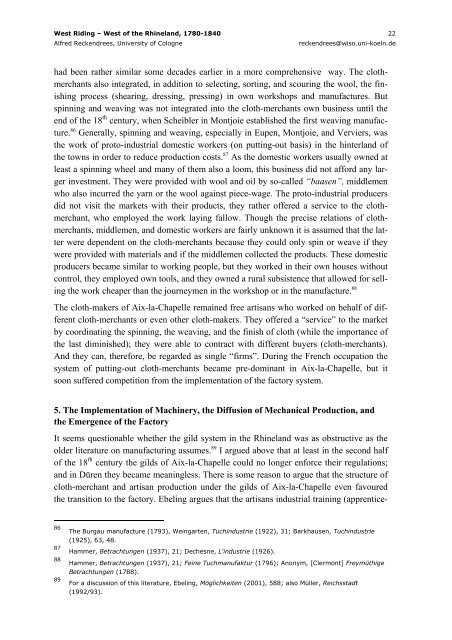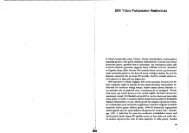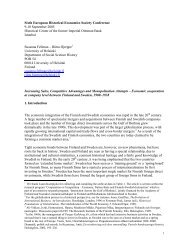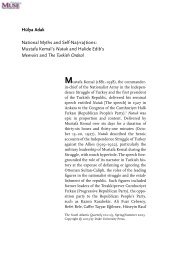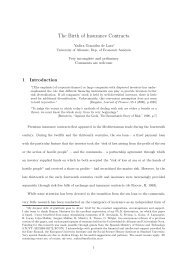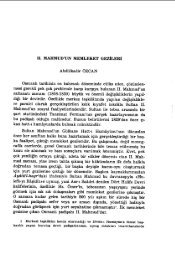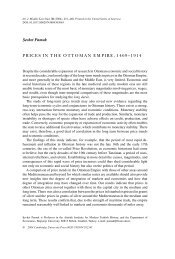West Riding – Western Rhineprovince, 1790-1840: Diverse Paths to ...
West Riding – Western Rhineprovince, 1790-1840: Diverse Paths to ...
West Riding – Western Rhineprovince, 1790-1840: Diverse Paths to ...
Create successful ePaper yourself
Turn your PDF publications into a flip-book with our unique Google optimized e-Paper software.
<strong>West</strong> <strong>Riding</strong> <strong>–</strong> <strong>West</strong> of the Rhineland, 1780-<strong>1840</strong> 22<br />
Alfred Reckendrees, University of Cologne reckendrees@wiso.uni-koeln.de<br />
had been rather similar some decades earlier in a more comprehensive way. The clothmerchants<br />
also integrated, in addition <strong>to</strong> selecting, sorting, and scouring the wool, the finishing<br />
process (shearing, dressing, pressing) in own workshops and manufactures. But<br />
spinning and weaving was not integrated in<strong>to</strong> the cloth-merchants own business until the<br />
end of the 18 th century, when Scheibler in Montjoie established the first weaving manufacture.<br />
86 Generally, spinning and weaving, especially in Eupen, Montjoie, and Verviers, was<br />
the work of pro<strong>to</strong>-industrial domestic workers (on putting-out basis) in the hinterland of<br />
the <strong>to</strong>wns in order <strong>to</strong> reduce production costs. 87 As the domestic workers usually owned at<br />
least a spinning wheel and many of them also a loom, this business did not afford any larger<br />
investment. They were provided with wool and oil by so-called “baasen”, middlemen<br />
who also incurred the yarn or the wool against piece-wage. The pro<strong>to</strong>-industrial producers<br />
did not visit the markets with their products, they rather offered a service <strong>to</strong> the clothmerchant,<br />
who employed the work laying fallow. Though the precise relations of clothmerchants,<br />
middlemen, and domestic workers are fairly unknown it is assumed that the latter<br />
were dependent on the cloth-merchants because they could only spin or weave if they<br />
were provided with materials and if the middlemen collected the products. These domestic<br />
producers became similar <strong>to</strong> working people, but they worked in their own houses without<br />
control, they employed own <strong>to</strong>ols, and they owned a rural subsistence that allowed for selling<br />
the work cheaper than the journeymen in the workshop or in the manufacture. 88<br />
The cloth-makers of Aix-la-Chapelle remained free artisans who worked on behalf of different<br />
cloth-merchants or even other cloth-makers. They offered a “service” <strong>to</strong> the market<br />
by coordinating the spinning, the weaving, and the finish of cloth (while the importance of<br />
the last diminished); they were able <strong>to</strong> contract with different buyers (cloth-merchants).<br />
And they can, therefore, be regarded as single “firms”. During the French occupation the<br />
system of putting-out cloth-merchants became pre-dominant in Aix-la-Chapelle, but it<br />
soon suffered competition from the implementation of the fac<strong>to</strong>ry system.<br />
5. The Implementation of Machinery, the Diffusion of Mechanical Production, and<br />
the Emergence of the Fac<strong>to</strong>ry<br />
It seems questionable whether the gild system in the Rhineland was as obstructive as the<br />
older literature on manufacturing assumes. 89 I argued above that at least in the second half<br />
of the 18 th century the gilds of Aix-la-Chapelle could no longer enforce their regulations;<br />
and in Düren they became meaningless. There is some reason <strong>to</strong> argue that the structure of<br />
cloth-merchant and artisan production under the gilds of Aix-la-Chapelle even favoured<br />
the transition <strong>to</strong> the fac<strong>to</strong>ry. Ebeling argues that the artisans industrial training (apprentice-<br />
86<br />
The Burgau manufacture (1793), Weingarten, Tuchindustrie (1922), 31; Barkhausen, Tuchindustrie<br />
(1925), 63, 48.<br />
87<br />
Hammer, Betrachtungen (1937), 21; Dechesne, L'industrie (1926).<br />
88<br />
Hammer, Betrachtungen (1937), 21; Feine Tuchmanufaktur (1796); Anonym, [Clermont] Freymüthige<br />
Betrachtungen (1788).<br />
89<br />
For a discussion of this literature, Ebeling, Möglichkeiten (2001), 588; also Müller, Reichsstadt<br />
(1992/93).


